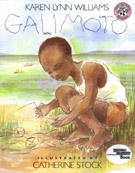I recently had a short email from an astute reader. I do not know if he was a teacher or librarian or student but he referred to my teacher’s guide on my website for galimoto. He suggested that I left out a major connections between the book, the children who build these amazing toys out of wire and how it all applies to technology and adaptation.
I guess when I first wrote the book, I was not technologically savvy. I am still a bit of a troglodyte. But I can see that connecting my little book to the work of technology would be another important use in the classroom or for reading at home. We all have to adapt to a world or technology and technology will help the human race adapt to an ever changing world.
As a writer I learned that in a changing world the meaning of your book changes. This is a lesson I will take to heart and hope to apply to my work published and not yet published.
And check out what this blog posted on Facebook has to say about Galimoto. Check out this thoughtful blogger for other posts too.:
Galimoto Connects Students to the World
Submitted by Trevor Barton on February 7, 2013
Blogs and Articles: Wealth and Poverty
Printer-friendly version
Last Christmas, I received a galimoto, a toy vehicle made by children from sticks, cornstalks, wire or other materials. Mine is a bicycle made of wire and ridden by a wire child wearing colorful clothing. The rider’s legs pedal as the wheels move. It’s beautiful in its simplicity, astonishing in its complexity. Mine was made in Kenya. I love it.
I brought my galimoto to school and showed it to my third-grade students. They too marveled at its design and pushed it around the classroom. “A kid made this?” Matthew asked. “Amazing!”
I really want to help my students connect to the world in real ways. I hoped some might find inspiration in the toy vehicle.
We located South Carolina on the globe and traveled with our fingers to Kenya. We imagined what it would be like to live there. What would the weather be like? What foods would we eat? What kind of house would we live in? What clothes would we wear? What would our school be like? What toys would we play with?
We read the book Galimoto by Karen Lynn Williams and illustrated by Catherine Stock.
“What do you notice when you look at the cover of the book?” I asked my students. “It looks like the little boy is poor,” answered Zaniya. “He’s wearing a torn tank top and shorts.”
I explained that I’d lived in a country called Mali in West Africa for three years. “Most of the children in my village had one set of clothes. Their parents didn’t have money to buy a lot of clothes. They had to use their money to buy food, shelter and medicine. So maybe this boy is like the children in my village.”
“He might be poor, but look at how smart he is. Look at the truck he’s making out of wire!” exclaimed Luis. Luis’ family moved to South Carolina from El Salvador a few years ago. His family works hard to meet their basic needs and make a better life here than they had in their country. Luis works slowly, speaks quietly and usually keeps his writing covered so we can’t see him struggle to put his thoughts and feelings onto paper. He is very observant and thoughtful.
We continued the exploration by watching a Reading Rainbow episode about galimotos. My students journeyed with a boy named Kondi as he collected wire to make a galimoto. He encountered challenges. His brother tells him that making a truck is much too hard for someone as young a Kondi. “His brother shouldn’t tell him he can’t do it,” said Chris. “He should help him.”
I gave students a journal assignment to write a paragraph about a toy they would like to make. I asked: What toy would you choose? How would you make it? Who would help you make it? Would someone play with it with you? I modeled a paragraph on the Promethean Board.
Zaniya wrote about making a toy puppy. Chris wrote about creating a video game system. Luis wrote about designing an instrument.
Luis brought his paragraph to me for revisions. He wrote:
I would make an instrument. I would need wood and wire to make an instrument like a cello. It might be small and broken looking, but it would make beautiful music. I would play it for my friends. I would play it for Mr. Barton.
Luis and all my students are, like the galimoto, astonishingly complex. Despite their economic circumstances, they are capable of sharing amazing insights and creating beauty. They are all beautiful gifts to me and to the world. As their teacher, I can help them develop that beauty and find beauty in others.
Barton is an elementary school teacher in South Carolina.
Add new comment


